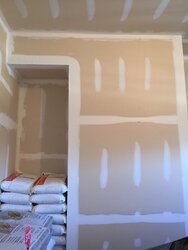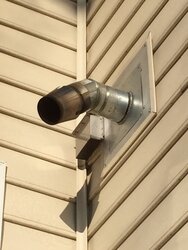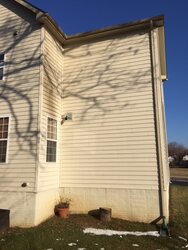Hello pellet stove venting experts,
I am in need for some good advice on improving/modifying the venting configuration on my stove. A "professional" dealer installed it April 2014 and as time passes by I keep finding all the stuff he did wrong (reading the comments on the forum helped a lot!). He charged very little, but also delivered very little, so I guess you get what you pay for he is no longer in business.
he is no longer in business.
We had some issues with stove earlier this year that got resolved - at this point we are operational and actually are getting some good heat from the stove. But, I can only go up to feed rate 3 before pellets spill unburned into the tray and my house siding is taking a soot beating! I suspect this setup is just all wrong.
I have been talking to some local installers on what do to and got some ideas, but before I make any final decisions, I wanted to share this and see what you think. So here is our current setup and some pictures.
My fireplace box protrudes into my garage like this. Stove sits in a zero clearance box. The vent goes up about 4ft and then side vented about 6 feet outside:

As you can see, it only sticks out about a foot and is very close to the top of the window and siding. The OAK is at the same level (slightly above the actual vent termination):
Here is the termination outside:

Full height view:

I am not proud of this, I knew nothing when it was put in and trusted my installer to do his job. I am better educated now. So here are the questions:
1. How bad/wrong is this install?
As I said we are operational, but do you see any risks of even running as is right now? obviously my siding is not getting any better, but the stove is running fine. So my current plan is to finish the season and then address.
2. How would you address?
Some installers suggested to extend the vent by adding a clean out T and then take it up a few feet, or even all the way up - this will move it away from the window, make it terminate above the OAK and fix the siding issue. However, I am worried that by adding another extension on top of that 5-6 feet horizontal run it will make my venting even worse overall. What do you think? Is this a good direction?
Another option suggested was to abandon this vent completely and run a direct vent up thru the roof. I do have finished space above the stove, but its a closet so it can be done, but this will be much more involved and expansive to do - so I am not thrilled about it.
Any other ideas? let me know!
Thanks!
I am in need for some good advice on improving/modifying the venting configuration on my stove. A "professional" dealer installed it April 2014 and as time passes by I keep finding all the stuff he did wrong (reading the comments on the forum helped a lot!). He charged very little, but also delivered very little, so I guess you get what you pay for
 he is no longer in business.
he is no longer in business.We had some issues with stove earlier this year that got resolved - at this point we are operational and actually are getting some good heat from the stove. But, I can only go up to feed rate 3 before pellets spill unburned into the tray and my house siding is taking a soot beating! I suspect this setup is just all wrong.
I have been talking to some local installers on what do to and got some ideas, but before I make any final decisions, I wanted to share this and see what you think. So here is our current setup and some pictures.
My fireplace box protrudes into my garage like this. Stove sits in a zero clearance box. The vent goes up about 4ft and then side vented about 6 feet outside:

As you can see, it only sticks out about a foot and is very close to the top of the window and siding. The OAK is at the same level (slightly above the actual vent termination):
Here is the termination outside:

Full height view:

I am not proud of this, I knew nothing when it was put in and trusted my installer to do his job. I am better educated now. So here are the questions:
1. How bad/wrong is this install?
As I said we are operational, but do you see any risks of even running as is right now? obviously my siding is not getting any better, but the stove is running fine. So my current plan is to finish the season and then address.
2. How would you address?
Some installers suggested to extend the vent by adding a clean out T and then take it up a few feet, or even all the way up - this will move it away from the window, make it terminate above the OAK and fix the siding issue. However, I am worried that by adding another extension on top of that 5-6 feet horizontal run it will make my venting even worse overall. What do you think? Is this a good direction?
Another option suggested was to abandon this vent completely and run a direct vent up thru the roof. I do have finished space above the stove, but its a closet so it can be done, but this will be much more involved and expansive to do - so I am not thrilled about it.
Any other ideas? let me know!
Thanks!
Last edited:


